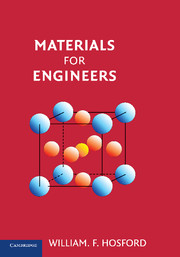Book contents
- Frontmatter
- Contents
- Preface
- 1 Introduction
- 2 Phases
- 3 Diffusion
- 4 Mechanical Behavior
- 5 Mechanical Failure
- 6 Annealing
- 7 Iron and Steel
- 8 Nonferrous Metals
- 9 Casting and Welding
- 10 Solid Shaping
- 11 Polymers
- 12 Polymer Processing
- 13 Glasses
- 14 Crystalline Ceramics
- 15 Powder Processing
- 16 Pottery and Concrete
- 17 Composites
- 18 Carbon
- 19 Fibers, Foams, and Porous Materials
- 20 Electrical Properties
- 21 Optical and Thermal Properties
- 22 Magnetic Materials
- 23 Corrosion
- 24 Modern Manufacturing Techniques, Surface Treatments, and Recycling
- APPENDIX 1 Wood
- APPENDIX 2 Miller Indices for Planes and Directions
- APPENDIX 3 X-ray Diffraction
- APPENDIX 4 Surfaces
- APPENDIX 5 Dislocations
- APPENDIX 6 Avrami Kinetics
- APPENDIX 7 Organic Chemistry
- APPENDIX 8 Average Molecular Weight
- APPENDIX 9 Bond Geometry in Compounds
- APPENDIX 10 Weibull Analysis
- Index
- Conversions
10 - Solid Shaping
Published online by Cambridge University Press: 05 June 2012
- Frontmatter
- Contents
- Preface
- 1 Introduction
- 2 Phases
- 3 Diffusion
- 4 Mechanical Behavior
- 5 Mechanical Failure
- 6 Annealing
- 7 Iron and Steel
- 8 Nonferrous Metals
- 9 Casting and Welding
- 10 Solid Shaping
- 11 Polymers
- 12 Polymer Processing
- 13 Glasses
- 14 Crystalline Ceramics
- 15 Powder Processing
- 16 Pottery and Concrete
- 17 Composites
- 18 Carbon
- 19 Fibers, Foams, and Porous Materials
- 20 Electrical Properties
- 21 Optical and Thermal Properties
- 22 Magnetic Materials
- 23 Corrosion
- 24 Modern Manufacturing Techniques, Surface Treatments, and Recycling
- APPENDIX 1 Wood
- APPENDIX 2 Miller Indices for Planes and Directions
- APPENDIX 3 X-ray Diffraction
- APPENDIX 4 Surfaces
- APPENDIX 5 Dislocations
- APPENDIX 6 Avrami Kinetics
- APPENDIX 7 Organic Chemistry
- APPENDIX 8 Average Molecular Weight
- APPENDIX 9 Bond Geometry in Compounds
- APPENDIX 10 Weibull Analysis
- Index
- Conversions
Summary
Bulk Forming
Processes for forming solid metals can be classified as bulk forming in which the forces are mostly compressive, and sheet forming in which the metal is stretched in tension. Bulk forming processes may be further classified as either hot working or cold working, depending on whether the work material leaves in a recrystallized state.
Figure 10.1 illustrates several important bulk forming processes. Compression is clearly the dominant force in rolling, extrusion, and forging. For rolling, extrusion, and forging, the reduction is usually limited by the capacity of the machinery to deliver forces. Although drawing involves pulling a rod or wire through a die, the pressure the die exerts on the rod or wire is the dominant force. In rod and wire draw-ing, the maximum reduction per pass is limited by the possibility of tensile failure of the drawn wire. Typically a maximum strain per pass is about ε = ln(A1/A2) = 0.65, which corresponds to a diameter reduction of 38%. Obviously many passes are required to make fine wire. Many rolling passes are used to make sheets and shapes. Forging uses repeated blows to achieve a final shape. In contrast, rods, tubes, and other shapes are extruded in a single operation to their final shape because high reductions are possible.
- Type
- Chapter
- Information
- Materials for Engineers , pp. 105 - 109Publisher: Cambridge University PressPrint publication year: 2008



